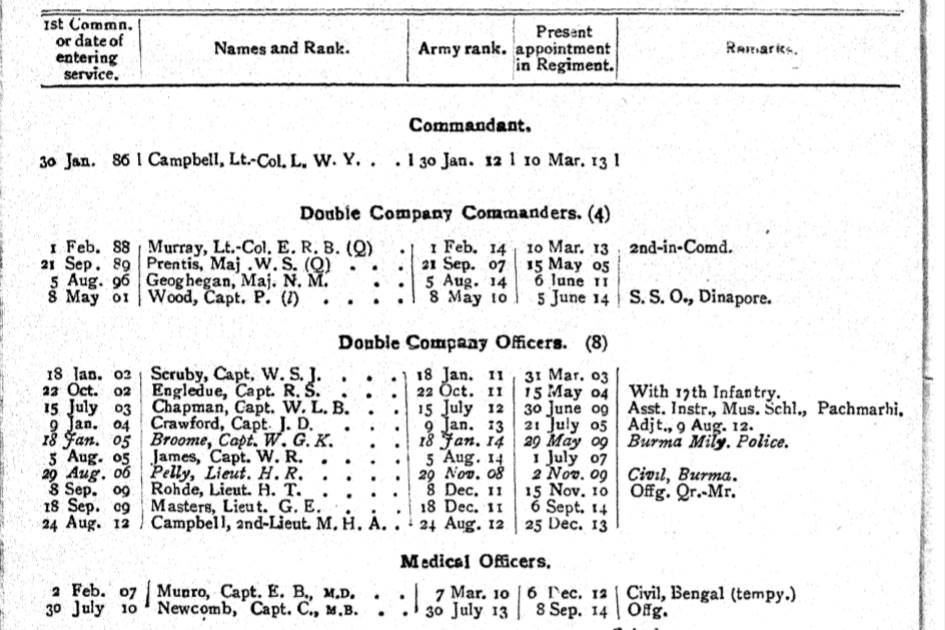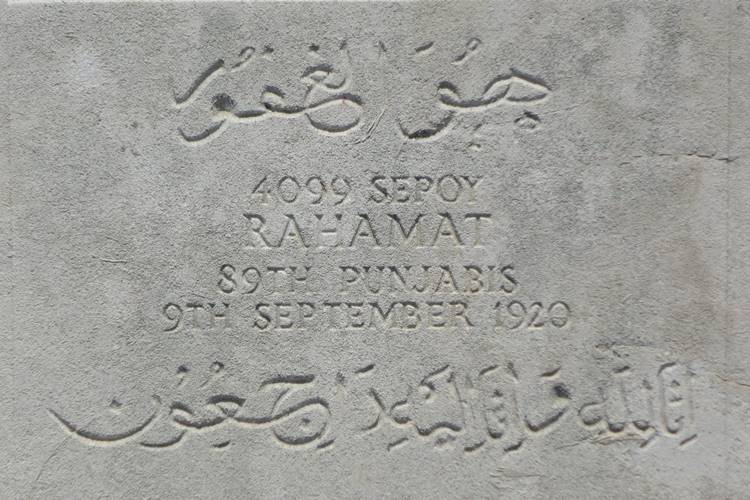This article on the 89th Punjabis aims to help you research the Regiment and those who served with it during the First World War. I have written a second article on the war-raised 2nd Battalion 89th Punjabis and have created a series of guides to help you research those who served in the Indian Army during the war. The links below will take you to the guides:
- Guide to the 2nd Battalion 89th Punjabis
- Guides to Researching Soldiers who Served in the Indian Army
The 89th Punjabis in the First World War
Lineage: Raised at Masulipatam (Machilipatnam) by Captain A. Macleod in 1798 as the 3rd Extra Battalion of Madras Native Infantry of drafts from the 2nd, 7th, 8th, 10th and 11th regiments. Then in 1800, it became the 1st Battalion, 15th Regiment of Madras Native Infantry and then the 29th Regiment of Madras Native Infantry in 1824. Then the 29th Regiment of Madras Infantry in 1885 and the 29th Regiment (7th Burma Battalion) of Madras Infantry in 1893. Then the 29th Burma Infantry in 1901, the 89th Punjabis in 1903 and the 1st Battalion 8th Punjab Regiment in 1922.
Composition in 1914: 3 Companies of Sikhs, 1 Company of Brahmans, 1 Company of Rajputs and 3 Companies of Punjabi Muslims. 1919: 1 1/2 Companies of Sikhs, 1/2 a Company of Brahmans, 1/2 a Company of Rajputs and 1 1/2 a Companies of Punjabi Muslims.
Location in July 1914: The 89th Punjabis was stationed at Dinapore (Danapur, Bihar, India) having arrived from Meiktila, Burma (Mandalay, Myanmar) on 17th April 1914.
The 89th Punjabis served in more theatres of war than any other Indian infantry regiment during the First World War. When the First World War began in August 1914, the Regiment was stationed at Dinapore, now Danapur in Bihar. The extract below was taken from the October 1914 Indian Army List and recorded the British officers serving with the Regiment.

The 89th Punjabis landed at Basra on 6 January 1916 and served in Mesopotamia until late 1918. The Regiment suffered heavy casualties during the battles to relieve the besieged 6th (Poona) Division at Kut-al-Amara. To learn more about the 89th Punjabis’ movements in Mesopotamia I would recommend downloading the two Mesopotamia war diaries I have discussed below. In November 1918, the Regiment moved to Salonika (Thessaloniki, Greece) and subsequently to Uchantar (5 miles north-west of Salonika). In January 1919, the 89th Punjabis moved to Batum (Batumi, Georgia) and then Tiflis (Tbilisi, Georgia) and remained in the area for the rest of the year. In 1920 the Regiment returned to India and became the 1st Battalion 8th Punjab Regiment in 1922. Below is the grave of Sepoy Rahamat, 89th Punjabis and who is buried in the Haidar Pasha Cemetery, Istanbul.
War Diaries of the 89th Punjabis
There are six war diaries for the 89th Punjabis which reflect the wide variety of theatres the Regiment served in. Of the six war diaries, only three have been digitized and the others can only be seen by visiting the National Archives. However, the war diary which covers the Regiment’s brief service in Gallipoli is available on Ancestry. I have copies of all war diaries and have transcribed some of the entries below.
- Date: 11 October 1914 – 30 April 1915
- Suez Canal Defences, Egyptian Expeditionary Forces
- Reference: WO 95/4432
- Notes: An average war diary which mainly consists of short entries. However, there are two good appendices describing the Action at Sheikh Sa’id on 10 November 1914 and the Turkish attack on the Suez Canal in February 1915. Additional appendices include instructions from the Brigade and a short intelligence report on the enemy in front of Kantara, January 1915.
- Date: 02 April – 31 May 1915
- 29th Indian Infantry Brigade, Gallipoli
- Reference: WO 95/4272
- Notes: A short war diary with lots of detailed entries during May 1915 describing life in the trenches. Contains a rough A4 sketch of “First Line Trenches held by 89th Punjabis” on 9th May 1915 by Captain Crawford.
- Date: 01 June – 31 December 1915
- 7th Ferozepore Infantry Brigade, 3rd (Lahore) Division
- Reference: WO 95/2924/1
- Notes: A good, detailed war diary with plenty of appendices which has been digitized and is available to download from the National Archives’ website
- Date: 01 January – 17 August 1916
- 7th Indian Infantry Brigade, 3rd (Lahore) Division, Mesopotamia
- Reference: WO 95/5107/3
- Notes: A very good war diary with a large number of appendices which include a number of maps. With appendices, the war diary is over 250 pages in length, with good accounts of the part played by the 89th Punjabis in the Kut relief attempts, including an “Account of Action on Morning of 11th March 1916 giving part played by 89th Punjabis”.
- Date: 01 October 1917 – 30 September 1918
- 53rd Indian Infantry Brigade, 18th Division, Mesopotamia
- Reference: WO 95/5226/5
- Notes: Another good war diary with plenty of appendices found throughout. Very little occurred from October 1917 – March 1918. A detailed account of the attack on Atyiahs Khan, Najaf (19 March 1918) and the subsequent response (Blockade of Najaf, Appendices relating to the blockade of Najaf with maps). After the 89th Punjabis marched to Kufa on 5th March 1918, daily entries become shorter. This war diary has been digitized and is available to download from the National Archives’ website.
- Date: 01 October 1918 – 30 November 1919
- 81st Infantry Brigade, 27th Division
- Reference: WO 95/4893
- Notes: Between October 1918 and February 1919 very little happened and many entries consist of “Company parades”. From March 1919 entries become longer but again very little occurred. The deaths of Indian Other Ranks are recorded throughout along with their regimental number, rank and name. There are appendices throughout the war diary including an interesting Programme of Sports Batoum 15-16 October 1919.
Further Sources for the 89th Punjabis
A good source of information for the 89th Punjabis is its regimental confidential reports which are held at the British Library: Confidential Reports on Regiments etc. These reports also contain the annual reports of the British officers who were then serving with the Regiment. However, when the Regiment is overseas only the Depot and the officers serving with it are reported on. For information regarding British and Indian officers who served with the 89th Punjabis, the Indian Army List can be consulted. There is also a regimental history: History of the 1st Battalion 8th Punjab Regiment.
Extracts from War Diaries of the 89th Punjabis
02 April – 31 May 1915, Gallipoli, WO 95/4272
13th May 1915 – 2.30 am – Heavy firing from trenches occupied by 7th Manchester Regiment on our right. This drew enemy shrapnel fire on to ravine causing several casualties to a Manchester fatigue party working on side of ravine, who in absence of their own medical officer were attended to by our regimental medical officer.
4.30 am- Regiment ordered to be ready to cover a further advance on the left by fire. But only to fire if enemy seen moving or entrenching.
5.45 am – F Company opened fire.
6.45am – Captain Scruby reports Gurkhas seen advancing on left, enemy also advancing. Captain Scruby ordered to open fire.

